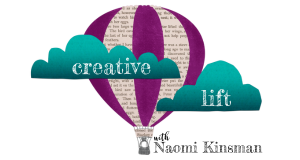Visit the Writerly Play Attic and work through a step-by-step activity to develop your courage. Never heard of the WP Attic? Learn how Writerly Play thinking strategies supercharge your creativity here.

I used to think fear was a weakness. I thought that maturity meant moving beyond fear. Whenever I felt fear, I switched into doubt-myself mode, consulting everyone around me for advice. If a person appeared fearless, I assumed they were also an expert.
It took me a long time to realize a number of important things:
- Just because someone appears fearless doesn’t mean they are.
- Innovators live outside their comfort zone, which means they face fear on a regular basis.
- Fear isn’t rooted in a lack of knowledge, courage, or capacity.
- If someone doesn’t feel fear now and then, she likely isn’t truly stretching herself.
- When I push into and beyond my fear, I’m doing my job. I’m being a confident, capable leader.
When I was younger, I’d do a small, daring thing and feel slightly smug. Fear? Whatever. I’ve got this. Now, I’ve learned fear comes in many sizes. If I’m a tad anxious about doing a live video session, but I shrug my concern off and go for it, I’ve done a good thing, sure. But pushing past larger-scale fear usually costs more than momentary discomfort.
For instance, now that I’m running a non-profit organization, the stakes are high. If someone asks me, “Are you sure that new program will work?” answering, “Let’s give it our best try,” feels like walking onto a tightrope with no safety net. Taking steps forward means risking relationships, our reputation, and even putting people’s jobs on the line.
It’s important to calculate our risk-taking and to make wise decisions. However, I’ve learned that caution can lead to disaster, too. Too much caution can result in completely missed opportunities.
So, what are the practical steps to take to develop your courage?
1. Identify the challenge. Spend time exploring the actual situation and possible goal.
Here’s an example. Like many artists, I wrestle with how to make a living while staying true to my creative heart. It’s easy to make a snap decision about what I need to do. “If I win the Newberry, I’ll have it made!”
The trouble is, my snap-decision solutions tend to be out of my control and beyond my current reach. They create road-blocks rather than forward momentum. So, instead, what if I ask myself: What is my actual goal? Or, if that question doesn’t yield a helpful answer, I might ask: What might success look like?
Or if all else fails, I might ask myself a series of “why” questions:
“Why do I want to win the Newbery?”
“Because teachers will invite me to visit their classrooms to work with their young writers.”
“Why do I want to work with young writers?”
“Because I want to create meaningful experiences for kids who are like the kid I was …”
“Why else?”
“Because I can make a living being creative and also make a difference in the world.”
And, wha-la! I’ve landed at the heart of things.
2. Focus on a proactive question. Start with the question at the heart of your challenge and brainstorm solutions.
Our brains are like computers. When we put a question in, they go to work to solve the question we’ve asked. If we ask a proactive, expansive question, we are much more likely to end up with a workable solution.
In my case, I’d ask: How can I make a living being creative and also make a difference in the world? In the end, my solution may involve writing Newberry-worthy books and working with young writers. But, the landscape also opens up for other possibilities as well. No matter what, by asking a more open question, I’m more likely to find a solution that will work *right now* to keep me in motion toward those life-long dreams.
3. Choose a solution. Take the time you need to research, ask for advice, and review pros and cons. Then, make a firm decision.
When we’re afraid, we fuss and fret and keep our options open. However, solving a problem by moving in twenty directions won’t yield strong results. When we water down our efforts, we water down our progress. Once you’ve chosen a solution, give it an honest chance. Focus your effort on your plan and boldly go for it.
4. Start. Begin with the first possible action.
By starting with the first possible action, you avoid the procrastination that comes from exploring additional options, researching, fretting, planning, and generally over-preparing. No amount of pre-thinking will keep you from running into unexpected challenges. There is no perfect way to roll out your solution. So, since the process is going to be messy, you might as well start, right?
5. Keep moving. Keep taking the next obvious step, one after the other.
That’s it! This strategy may look straightforward and practical, but it is by no means easy. Expect detours and sink-holes. Be prepared to turn a corner only to run straight into fear yet again. Instead of running, reach out your hand. Invite fear to come along as you *keep moving*.
Many of you are facing your fear as we speak.
You’re pushing forward into the unknown creatively, personally, professionally. If that’s you, I want to say … I’m tremendously excited for you. I can’t wait to see what beautiful things you bring into the world because of your courage and determination. I’m excited for those of you who are about to tackle your fear, too.
I’ll be here, cheering you on, so don’t forget to share your progress with me. Not just the wins, either. I want to hear your story—the ups AND the downs. You can always share with me on the blog, or you can email me and tell me your story. Or, connect with me on Instagram or Twitter. Your story matters.
Here’s to you and your courageous heart.

